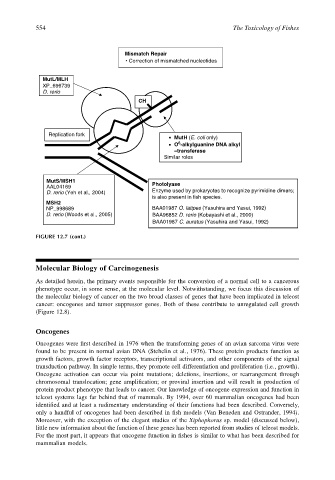Page 574 - The Toxicology of Fishes
P. 574
554 The Toxicology of Fishes
Mismatch Repair
• Correction of mismatched nucleotides
MutL/MLH
XP_696739
D. rerio
CH
Replication fork
MutH (E. coli only)
6
O -alkylguanine DNA alkyl
–transferase
Similar roles
MutS/MSH1
AAL04169 Photolyase
D. rerio (Yeh et al., 2004) Enzyme used by prokaryotes to recognize pyrimidine dimers;
is also present in fish species.
MSH2
NP_998689 BAA01987 O. latipes (Yasuhira and Yasui, 1992)
D. rerio (Woods et al., 2005) BAA96852 D. rerio (Kobayashi et al., 2000)
BAA01987 C. auratus (Yasuhira and Yasui, 1992)
FIGURE 12.7 (cont.)
Molecular Biology of Carcinogenesis
As detailed herein, the primary events responsible for the conversion of a normal cell to a cancerous
phenotype occur, in some sense, at the molecular level. Notwithstanding, we focus this discussion of
the molecular biology of cancer on the two broad classes of genes that have been implicated in teleost
cancer: oncogenes and tumor suppressor genes. Both of these contribute to unregulated cell growth
(Figure 12.8).
Oncogenes
Oncogenes were first described in 1976 when the transforming genes of an avian sarcoma virus were
found to be present in normal avian DNA (Stehelin et al., 1976). These protein products function as
growth factors, growth factor receptors, transcriptional activators, and other components of the signal
transduction pathway. In simple terms, they promote cell differentiation and proliferation (i.e., growth).
Oncogene activation can occur via point mutations; deletions, insertions, or rearrangement through
chromosomal translocation; gene amplification; or proviral insertion and will result in production of
protein product phenotype that leads to cancer. Our knowledge of oncogene expression and function in
teleost systems lags far behind that of mammals. By 1994, over 60 mammalian oncogenes had been
identified and at least a rudimentary understanding of their functions had been described. Conversely,
only a handful of oncogenes had been described in fish models (Van Beneden and Ostrander, 1994).
Moreover, with the exception of the elegant studies of the Xiphophorus sp. model (discussed below),
little new information about the function of these genes has been reported from studies of teleost models.
For the most part, it appears that oncogene function in fishes is similar to what has been described for
mammalian models.

